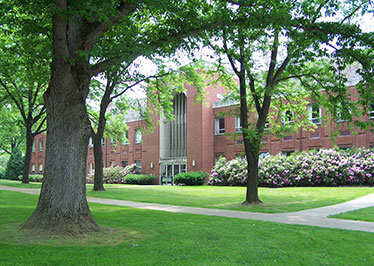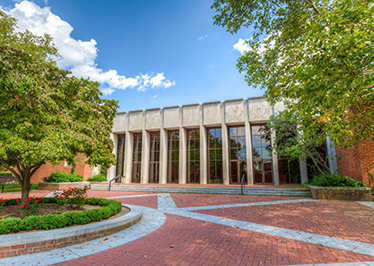Part five of a series on the iconic architecture of campus by Alyssa (Jackson ’19) Bootsma
Following the 40-year leadership of Weir C. Ketler, Dr. J. Stanley Harker became president of Grove City College in 1956 and oversaw campus construction projects that completed the master plan laid out decades earlier.
But the campus building that bears the Harker name was dedicated not to the 1925 alumnus, but to his wife, Helen (Calderwood ’23) Harker. She was the daughter of Alva J. Calderwood, an 1896 graduate of the College who was a professor and then dean who served the College for 53 years. Calderwood’s legacy lived on in his daughter as the student body grew to love her as their first lady and decided in 1971 to dedicate the new women’s residence hall in her honor. Helen Harker Hall was finished and dedicated in 1971, the final year of her husband’s presidency.
During the Harker era, new buildings sprung up all over campus. Though most were built out of necessity due to the growth of the college, Harker also finalized the original Olmstead plan to move the core of the College to upper campus.
Along with that came the demolition of old buildings on lower campus that were in disrepair and no longer needed. Many of the buildings served nearly three-quarters of a century before being torn down, but the time had come. Recitation Hall and the Ivy Chapel were torn down in 1959, Founders Hall in 1962, and the Music Hall and the Physics Building in 1964.
Expansion was one of Harker’s initiatives and he successfully grew the College to attract prospective students from far beyond the region. The student body grew from 1,200 to 2,056 and the number of faculty members increased from 80 to 120. As well as Harker Hall, new dormitories were built to accommodate the influx of students. North Hall was added in 1961 and Hicks Hall in 1967. It was named in honor of Lewis W. Hicks, who was known as the “stalwart of the Board of Trustees” for his service from 1944 until his death in 1965. He was also a successful businessman, co-founding the Allegheny Steel Company, founding and serving as president of the First National Bank of Leechburg, Pa. and the CEO of many mining companies.
After a less-than-stellar accreditation evaluation in 1957, Harker made it a point to extensively revise the curriculum, build up the library resources, increase salaries to attract faculty and better the health care on campus. Each of these components also led to more buildings to fill these needs.
 Hoyt Hall was dedicated in 1966, the same year renovations were made to the Hall of Science and it was renamed the Rockwell Hall of Science. Dr. Creig S. Hoyt was a 1913 graduate of the College and then served as professor for 44 years. During that time he also served as chair of the department of Chemistry, dean of the college and headed the War Science Engineering and Management Training program during WWII.
Hoyt Hall was dedicated in 1966, the same year renovations were made to the Hall of Science and it was renamed the Rockwell Hall of Science. Dr. Creig S. Hoyt was a 1913 graduate of the College and then served as professor for 44 years. During that time he also served as chair of the department of Chemistry, dean of the college and headed the War Science Engineering and Management Training program during WWII.
Zerbe Health Center was added in 1969 and dedicated in 1970. That moved the infirmaries out of the male and female dorms where they had previously been located. It provided 17 beds for patients and an apartment for a resident nurse. It was named for Arthur F. Zerbe, a College benefactor.
Changes to the campus continued under the presidency of Dr. Charles Sherrard MacKenzie who served from 1971-1991. When the showplace Pew Fine Arts Center was built in 1976, music education was moved to upper campus and the space it filled in Carnegie Hall was used for ROTC purposes until the 1980s.
 The Fine Arts Center is named after J. Howard Pew, a 1900 graduate who served as a Trustee of the College for nearly 60 years and Chairman of the Board for 40 of those years. The auditorium within the center is named in honor of former President Weir C. Ketler, and the Pew Memorial Room honors both J. Howard and Helen Pew. The Pews were known for their generosity and it is estimated they gave away 90 percent of their income. Grove City College benefited greatly from their generosity.
The Fine Arts Center is named after J. Howard Pew, a 1900 graduate who served as a Trustee of the College for nearly 60 years and Chairman of the Board for 40 of those years. The auditorium within the center is named in honor of former President Weir C. Ketler, and the Pew Memorial Room honors both J. Howard and Helen Pew. The Pews were known for their generosity and it is estimated they gave away 90 percent of their income. Grove City College benefited greatly from their generosity.
In addition to the new construction, under MacKenzie’s watch the College took a stand for independent, private education that led to a Supreme Court battle and the College’s eventual decision to forgo all federal funding, including student aid. The MacKenzie era also introduced the Keystone Curriculum, which required all students to take courses that provided a common grounding in the liberal arts tradition.
Along with academics, athletics was also revamped with the additions of Robert E. Thorn field in 1975 and the Phillips Field House in 1979. Robert E. Thorn was an impressive four-letterman in football, baseball, basketball and tennis. After graduating in 1916, he taught and coached at the high school level, but then returned to Grove City College to serve as Athletic Director from 1920-1957. He coached the basketball team to 21 consecutive victories from 1921-1922, reinstated tennis as a varsity sport and coached for 23 seasons, began the soccer program, coaching for 17 seasons and helped found intramural sports at the College.
Phillips Field House sits next to Thorn field and it replaced the Old Gym which had been built in 1912. It honors the physician Dr. Arthur W. Phillips, Grove City College class of 1916 and his wife through the Dr. and Mrs. Arthur W. Phillips Charitable Trust.
Another residence hall, Mary Ethel Pew Hall was added in 1982. Mary Ethel Pew was the sister of J. Howard Pew, and one of five children of Joseph Newton Pew. She served as member of the Board of Trustees from 1949-1979, a position few women held at the time. She also had a lot of say and gifted substantial amounts of her own money to the efforts of the College.
With the 1980s came a technological surge and Grove City College kept up with the addition of Weir C. Ketler Technological Learning Center in 1984. “Visiting educators have told us it is the most advanced and sophisticated undergraduate computer facility in the nation,” MacKenzie said at the dedication.
At the time, the building contained the most up-to-date computer technology of its time which was accessible for student use. It also houses printers, a lecture hall, classrooms and the print services office. Because the College instituted a laptop program in 1994 (issuing free laptops to every student), there are only a handful of computers for student use but a help desk now exists for students to bring their laptops in for repair and trouble shooting.
The TLC would be the last major building project on campus of the decade. The work that Harker and MacKenzie did to grow the College in size and stature from the 1950s to the 1990s was key to continuing the legacy of Grove City College.
Read the Building a Legacy Series
Part 1: Campus buildings tell College’s story
Part 2: Creating a campus in the community
Part 3: Growth in the midst of the Depression
Part 4: Weathering the war and completing the plan
Part 5: The Surge of the 60s, 70s and 80s
Part 6: The 21st century